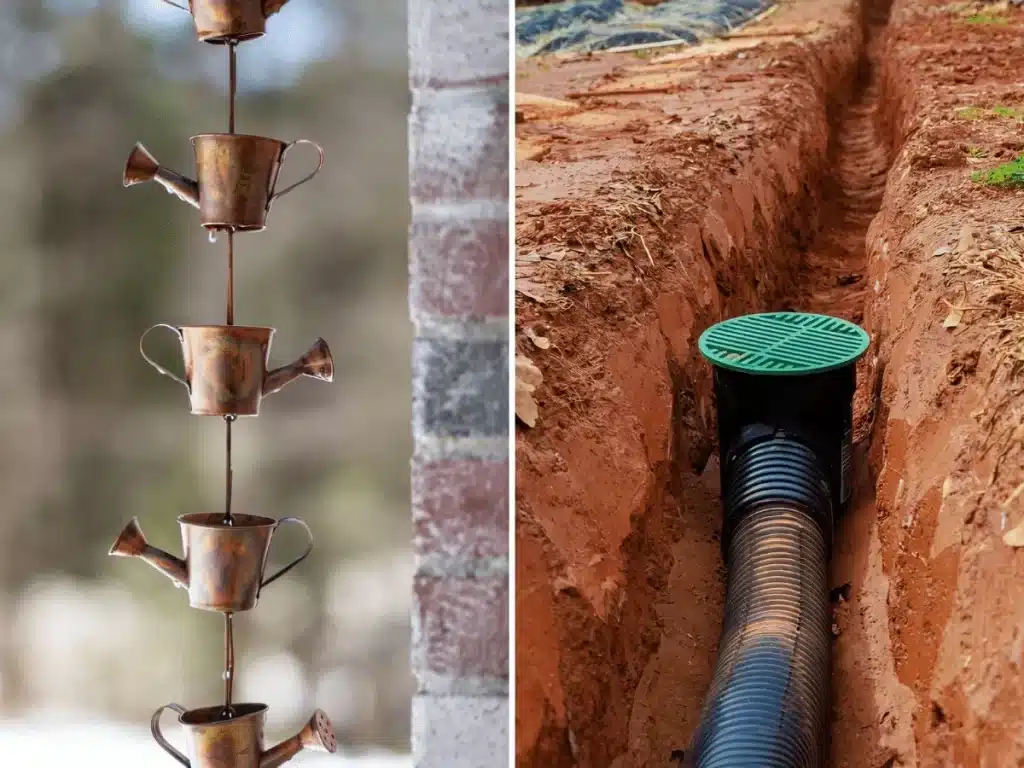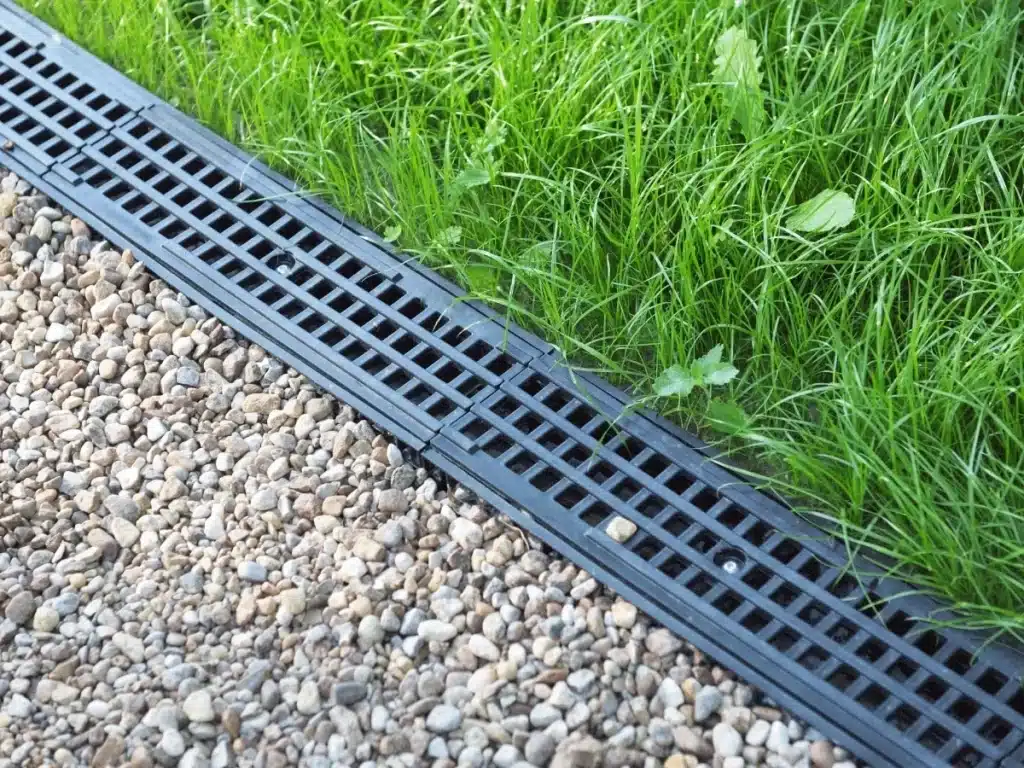
Are you tired of traditional gutters causing trouble? Are you seeking a new way to manage rainwater? Discover innovative, eco-friendly gutter alternatives that eliminate clogs and prevent water damage. Let’s find out the best alternatives to traditional gutters!
Best Gutter Alternatives for Your Home
When it comes to managing rainwater around your home, traditional gutters aren’t the only option. Several gutter alternatives can effectively channel rainwater away from your property while adding a unique touch to your home’s exterior
Rain Chains

Rain chains are a stylish, functional replacement for regular downspouts. They direct rainwater from the roof to the ground with linked cups or chains.
Types include link chains, cup styles, and decorative shapes like flowers or bells. Often seen in gardens, modern homes, and Japanese-style yards, they enhance visual appeal.
Made from durable metals like copper or stainless steel, rain chains come in various sizes and styles to match different roofs and water flow needs. Adjustable lengths ensure they fit your roof height. Designs range from simple links to complex patterns.
Rain chains manage rainwater flow, minimizing splash and erosion. They guide water gently to the ground or into a basin. Besides their practical use, they add beauty to your home and produce a calming sound as water trickles down, enhancing your outdoor area.
Imagine the gentle sound of rain cascading down a chain of cups—it’s both useful and delightful!
Drip Paths

Drip paths, simple ground-level solutions, guide water away from homes. Typically, made of stones or gravel, they’re placed in a trench beneath the roof edge.
These paths manage rainwater runoff, preventing soil erosion nearby. They are often found in gardens and yards with minimal drainage issues.
Various sizes and shapes of drip paths suit different landscapes. Shapes like straight lines or gentle curves often match the roofline. Trench depth and width can vary to suit water flow requirements, which permits customization for any property.
Materials for drip paths should be durable and weather-resistant. Stones, gravel, or concrete can create these paths, and need minimal upkeep. They also last many years. Material choice can also imrpove landscape aesthetics.
Drip paths primarily divert water from the foundation and guard against erosion. They also lessen puddling and mud accumulation around the home.
French Drains

French drains redirect water away from structures. They use gravel-filled trenches and perforated pipes. Commonly used in poorly drained areas, they protect against water damage and basement flooding.
With diverse sizes and shapes, French drains adapt to specific drainage requirements. Trench widths and pipe diameters vary to accommodate different water volumes. This makes them flexible for various buildings and water levels.
French drains intercept and redirect both surface and groundwater, protecting foundations and preventing erosion. They effectively keep water out of basements or crawl spaces, providing an alternative to conventional gutters.
Why opt for French drains? They discreetly manage water without visible gutters or constant cleaning. Moreover, they suit difficult landscapes and offer an effective yet concealed solution
Rainwater Harvesting Systems

Rainwater harvesting systems collect and store rainwater for later use. They include catchment areas, gutters, downspouts, storage tanks, and distribution mechanisms.
These systems are used in regions with water scarcity or for eco-friendly water management. They are specifically used for tasks like garden irrigation and toilet flushing.
They vary in size and shape to fit household or community needs. Storage tanks range from small barrels to large underground cisterns. Adaptable and customizable, they suit different spaces and requirements.
The main purpose of rainwater harvesting systems is to conserve water and reduce reliance on municipal supplies. They lower water bills and provide a sustainable water source.
Additionally, they mitigate runoff, minimizing erosion and flooding risks. This makes them practical and environmentally friendly.
Rainwater can also be used for gardening or even drinking with proper filtration. It’s fantastic to have a system that saves money and the environment. It also benefits homeowners and nature enthusiasts alike.
Green Roofs

Green roofs, also known as living roofs, turn ordinary rooftops into green spaces. They consist of layers of waterproofing, soil, and vegetation.
They are popular in urban areas for heat reduction and rainwater management. Imagine a lush garden above your head—that’s a green roof for you.
There are two main types of green roofs: extensive and intensive. Extensive green roofs are lightweight. They come with a thin soil layer suitable for low-maintenance plants.
Intensive green roofs, heavier with deeper soil, support a wider variety of plants. They can even work for small trees. Shapes and sizes vary, matching the building’s structure.
Functionally, green roofs absorb rainwater, reducing runoff and insulating buildings. They also cool urban areas, improve air quality, and provide habitats for wildlife. They’re not only practical but also transform dull rooftops into beautiful, eco-friendly spaces.
It’s a sustainable decision benefiting both the environment and your well-being, making green roofs a modern solution for eco-conscious living.
Permeable Pavers

Permeable pavers are materials that let water pass through, reducing runoff. Used in driveways, paths, and patios, they support weight while letting water seep through. Types include interlocking bricks, porous asphalt, and pervious concrete.
Sizes and shapes of these pavers vary. They can be small bricks, large stones, or custom shapes. Their porous nature makes them sturdy and durable.
Functionally, permeable pavers help manage stormwater by reducing runoff and aiding groundwater recharge. They filter pollutants, improving water quality. Moreover, they lessen flooding and erosion around your home.
Rain Gardens
Rain gardens are shallow, planted depressions that absorb rainwater. Often used in residential areas, they manage stormwater naturally. Types include pollinator gardens, which attract insects, and edible gardens, which grow food plants.
Rain gardens vary in size and shape, fitting different spaces and water goals. They can be small and round or larger, flowing designs. Plants are usually native species that tolerate both wet and dry conditions.
Functionally, rain gardens reduce runoff, filter pollutants, and boost groundwater recharge. They offer habitats for wildlife, including birds and insects. By capturing rainwater, they also cut the need for extra irrigation.
They are a beautiful, sustainable way to handle stormwater. Supporting local ecosystems, they add charm to any yard. They are perfect for homeowners seeking to combine beauty with ecological benefits.
Trench Drains

Trench drains are long, slim channels that gather and redirect surface water. They are often used in driveways, patios, and near pools to handle runoff.
Common types include plastic, concrete, and metal drains, each suited for specific uses. Designed to manage large water volumes, they are very efficient.
These drains come in various sizes and shapes. They can be custom-fit to any length and depth needed. Typically, they are linear, but they can also have grates in various patterns for added strength and looks. Their strong construction makes them suitable for busy areas.
Trench drains prevent flooding by moving water away from buildings. They help reduce erosion and keep areas dry. By managing runoff well, trench drains protect landscapes and building foundations.
Why should you choose trench drains? They are a strong solution for areas with heavy water flow. Ideal for both homes and businesses, trench drains mix efficiency with durability, making them a smart water management choice.
Drip Edge Extensions

Drip edge extensions are small devices attached to roof edges to guide water away. Used in places without gutters, they prevent water damage. Types include metal and plastic extensions, each fitting various roof styles. These extensions are easy to install and maintain.
Sizes and shapes of drip edge extensions can be simple or detailed. They usually come in lengths matching standard roof edges. Shapes can be straight or angled, based on roof design and water needs. Their materials ensure they withstand weather well.
Drip edge extensions protect roofs and siding from water damage. They help prevent leaks and reduce erosion around the foundation. By guiding water away from the structure, they keep the roof and walls in good shape.
Are Gutter Alternatives Effective?
Are gutter alternatives effective? Yes, they can be, depending on the situation and installation. Alternatives like rain chains, French drains, and swales effectively manage water. They work well in places where traditional gutters aren’t suitable or wanted.
Rain chains guide water from the roof to the ground in a controlled way. French drains redirect water away from the foundation, preventing damage. Swales help with water absorption, reducing runoff and erosion. These options are both functional and visually appealing.
However, effectiveness varies based on installation quality and site conditions. Proper placement and upkeep are crucial for success. If not installed correctly, they may not manage water as well as traditional gutters. So, it’s essential to assess the specific needs of your home.
In some cases, combining alternatives with gutters offers the best protection. This hybrid approach can address unique water management challenges.
The right solution depends on your home’s design and local climate. Consulting a professional can help determine the best option for your needs.
Frequently Asked Questions
Does My Home Need Gutters?
Your need for gutters depends on climate and landscape. Gutters are crucial in regions with heavy rain to avoid water damage. In dry areas or with flat roofs that have good drainage, they may be less necessary. However, most homes benefit from gutters to manage water runoff effectively.
Do Rain Chains Work as Well as Gutters?
Rain chains are a pretty alternative but might not offer the same protection. They work well for light to moderate rain but may struggle with heavy downpours. Rain chains are ideal for decoration and in areas with less rain. They aren’t a direct substitute for gutters in regions with frequent heavy rain.
What Is the Cheapest Alternative to Gutter Guards?
Inexpensive options include gutter screens or foam inserts. These are affordable, easy to install, and offer basic protection against debris. However, their effectiveness varies, and they might need frequent cleaning. Choose based on your needs and budget.
Is It Better Not to Have Gutters?
In some cases, like flat roofs or arid climates, gutters might not be needed. Without gutters, water can cause soil erosion, foundation damage, and other problems. Most homes benefit from having gutters to direct water away from the structure. It’s generally better to have gutters unless specific conditions suggest otherwise.
Why Do Old Houses Not Have Gutters?
Older homes might lack gutters due to different construction practices or climate considerations. Some relied on wide overhangs to manage water runoff. The need for gutters can also depend on historical rainfall patterns. Modern building practices recognize the importance of gutters in protecting home foundations and landscaping.
Can You Use a French Drain Instead of Gutters?
French drains can redirect water away from the foundation but may not offer the same protection as gutters. They are typically used with gutters, not as a replacement. French drains manage groundwater and surface water. Using both systems together provides comprehensive water management.
Why Do Modern Homes Not Have Gutters?
Some modern homes use alternative drainage systems or have features that eliminate the need for gutters. Designs may include sloped roofs, extended eaves, or integrated drainage solutions. In some cases, landscaping is designed to handle water runoff naturally. However, many modern homes still use gutters to effectively manage rainwater.
